When it comes to eCommerce link building, there might be quite a few things that companies might need support with.
That’s why we’ve created a comprehensive beginner’s guide that’ll take you through the process of building links for your eCommerce website efficiently.
To give you a taste of the topics we’re going to cover, this guide includes:
- What eCommerce link building is and why it’s important
- What the best way to find link opportunities for your eCommerce website is
- How to build a successful eCommerce link building campaign
Let’s jump right into the first section and explain what eCommerce link building is.
Link building cheat sheet
What is eCommerce Link Building?
eCommerce link building is all about building links back to your eCommerce site which can then boost your rankings on the search engines.
In other words, eCommerce, or electronic commerce, link building is when an online business is building high quality links back to their product page in order to increase their pages’ organic traffic and increase their website’s domain authority (DA).
Since algorithms take into account backlinks as a positive signal for a website or web page, backlinks are important for your eCommerce business. Link building is equally important for all platforms, so it doesn’t matter whether your store runs on BigCommerce or Shopify.
There are various link building tactics in terms of link building for eCommerce businesses.
One of the most prominent is to create content that people will want to link back to.
Graphics, infographics, tutorials, guides, well-thought-through pieces of content and statistics are some of the most linkable types of content.
Let’s have a look at Zola, a very successful registry and wedding planning eCommerce business.
The homepage, shown below, makes it crystal clear that the company is definitely creating useful, link-worthy, and shareable content for their audience:

As you can see, there’s pretty much everything one might need to know or use when it comes to wedding planning.
Let’s have a look at a specific example of unique and linkable content from Zola.

The page you see above is just one out of many detailed and useful checklists that the Zola team creates in relation to wedding planning and registries.
Let’s see how this Zola page is doing in terms of organic traffic and backlinks, according to Ahrefs:

The numbers of backlinks, referring domains and the organic keywords this Zola page ranks for are quite impressive for this industry, aren’t they?
Additionally, we can see that this eCommerce business also gets significant organic traffic, part of which may be due to the fact that Zola creates high-quality link worthy content.

We therefore understand that great content must definitely play a significant role when it comes to eCommerce search engine optimization (SEO) and the success of your business in terms of organic traffic and its search engine ranking on results pages (SERPs).
What’s great about creating and sharing informative content is that other people such as bloggers might find it useful to link back to your resources in order to give their audience examples for their statements, thus boosting your credibility and organic traffic.
Similarly, your great content could be used as a starting point for reaching out to influencers and so boost your social media marketing.
You’ve got a taste, but let’s get into more detail about why link building is important for your eCommerce business.
Why is eCommerce Link Building Important?
Are you wondering why eCommerce link building is important and how it can help eCommerce businesses get visibility for product-specific searches?
According to a study by Backlinko, pages with a higher number of backlinks are pages that tend to rank higher:

Which means that acquiring links is essential if you want your business to be included at the top of the SERPs.
Additionally, the 2021 census report shows that retail eCommerce sales are, in general, steadily increasing.
In fact, there has been a significant increase in retail eCommerce sales of 32.4 percent (±1.8%) from 2019 to 2020.
The increase proves that eCommerce stores and online retailers have great potential for growth in the coming years.
At the same time, though, competition is getting more intense as more and more players get into the game, and virtually every category will sooner or later be cluttered.
Having said that, backlinks can be a way to get better results faster and stand out in an already-cluttered space.
Let’s have a look at an example of a local search for the UK, using the search operator ‘slippers’, what our American readers will know as ‘house shoes’.

Here’s an overview for the target term ‘slippers’ from the Ahrefs Keyword Explorer:

As we can see, this is a term with cost-per-click (CPC) of $1.00, which means that there are advertisers and brands on the SERPS who are bidding for the term.
Given the value of the term, eCommerce businesses would naturally want to have visibility for it.
Let’s now have a look at the SERP overview for the target term we’re focusing on.

Author’s Note: Due to browser preferences and general browser behaviour, there are some differences between the two screenshots from Ahrefs and Google.
The results at the top are usually the ones that have the most links from other websites.
We need to mention that the number of backlinks from relevant referring domains is only one of Google’s ranking factors – there are other factors involved, such as brand awareness, overall website authority, etc. – but it’s a rather important one.
In other words, besides the brand, which definitely plays a key role in search – i.e. people are more inclined to click on a result by a popular brand like ASOS since it’s a brand they know already – eCommerce link building can help you get visibility for terms with commercial value for your business.
What is PageRank?
Whenever the topic of link building comes up, there’s a certain buzzword that soon follows.
That buzzword, is, of course, PageRank, AKA “link juice”.
PageRank is one of the core algorithms that make up the greater Google… algorithm.
It’s not publicly available (anymore), but what it is is essentially a score that each page is assigned depending on the quantity and quality of its inbound link profile.
More links = more PageRank = higher rankings in search results.
That’s the most basic explanation of the system – and things are not so black-and-white in reality.
Let’s get into some additional nuances of eCommerce link building. More specifically, which links are actually good for your SEO.
What Makes a Good eCommerce Backlink?
During link acquisition for your website, you want the absolute cream-of-the-crop: not forum and directory links or blog comments.
There are several important qualities a link must possess in order to be considered “good”.
Linking Domain’s Age and Authority
Older domains are seen as more trustworthy by Google. They have had the time to establish thought leadership and strong backlink profiles.
Domain Authority and Domain Rating are two metrics that function almost exactly the same: one is developed by Moz, the other one – by Ahrefs.
Both of them give scores to entire domains based on their backlink profiles – a lot like PageRank, just sitewide.
Number of Other Links on the Page
Ideally, you want links from pages with few external links.
This is because the PageRank a page is able to pass on is distributed through all of its outgoing links.
So, more total links = less PageRank distributed by each individual link.
Relevance
This one is rather straightforward – you don’t want links from a dog grooming website to one that sells sports equipment.
Anchor Text
Besides just being relevant, your links’ anchor texts also need to include some variation of your page’s target keyword in it.
Exact-match and partial-match anchor texts are the best for SEO purposes, as they help your pages rank in SERPs for these keywords.
Rel Tag
Rel tags are HTML bits of code each backlink has.
There are many different rel tags available, but the 4 most important for eCommerce link building are :
- rel=dofollow (or rel=follow)
- rel=nofollow
- rel=UGC
- rel=sponsored
Dofollow links pass on PageRank.
All the other tags don’t. If a link has neither of these, it’s automatically dofollow.
This is important, as a lot of other eCommerce link building guides focus on link building strategy types that get sponsored and UGC links (such as product reviews, influencer marketing, Google Ads, etc.).
In our guide, we will show you how to get dofollow links – the only ones that actually help with SEO.
You now know why link building can be very beneficial for your online store.
We think you’ll be thrilled to know more about which are the best ways to find links for your brand.
Let’s get into it.
What’s the Best Way to Find Links for Your eCommerce Website?
We’ve already established why getting links can help your eCommerce store increase its visibility and help you rank higher.
What we need to note is that both internal links, that you include in one page of your website to another page or resource of your website, as well as inbound links, that are links from other websites, can help your eCommerce SEO, as well as boost the effectiveness of your content marketing.
On the other hand, it’s also important to highlight that, when it comes to link building, especially if our product pages or category pages are the most important ones – and the ones we’d like to have backlinks to – it can be tricky to get links back to those pages.
For that reason, we have to find an alternative way of generating backlinks and improving our website’s overall authority and trustworthiness.
Many businesses might focus on a number of link building strategies like finding broken link opportunities (error 404 not found), or looking for unlinked mentions, etc.
Naturally, since they’re interested in promoting their product pages, they’re reaching out to website owners and asking for links directly back to their product pages.
We believe that this isn’t as effective, since most people wouldn’t be inclined to link back to a product page.
One of the most efficient ways is to create valuable content around your products and try to build links back to these pages.
From there, you can add internal linking back to your product pages and pass on link equity, through dofollow backlinks, to your product pages.
Author’s Note: If you want to know more about the differences between dofollow and nofollow links, read the guide on our blog.
As you can imagine, people are far more likely to link back to a content page rather than a product page — this is why such a link building technique can work well for us.
We’re jumping right into an example.
Example: Perfect Keto
Perfect Keto is an eCommerce website that sells high quality keto supplements and keto diet products.

What they do is use their blog content to link back to other landing pages they have.
More specifically, a blog post about the best nuts for weight loss includes, among others, a link to a recipe landing page…

…which takes us to this recipe landing page:

…where we can find a link to a product page:

We can see that the brand is using their blog content to give internal links to their landing pages, which include links back to their product pages, which are naturally the ones they want to promote most.
Put another way, Perfect Keto internally link back to their landing pages and eventually to product pages, so the product pages can rank as well.
Here’s the product page we got to by following the links shown in the screenshots above:

In one sentence, links snowball into each other.
How does that work exactly?
Since they’re internally linking to the product pages from their blog post, that is also passing link equity to the product pages.
As simple as that!
Wanna see some data?

Even though the Ahrefs report doesn’t report internal link groups, we understand that with over 640 backlinks from 177 referring domains, the number of backlinks for this page is very high, especially considering that this is a product page.
In other words, by getting backlinks to your blog post, which is easier to do than getting them straight to your product pages, you can pass on link equity to your product pages, like Perfect Keto does.
That’s just one of the ways you can use to build links back to your eCommerce brand.
Keep reading to find out how this process can work for your own business.
Step-by-step Process for Effective eCommerce Link Building
We’ve already talked about what eCommerce link building is, as well as why it’s important for online businesses.
We’re now going to show you four simple steps that you can take to build your own effective link building campaign for your eCommerce using Respona.
As we usually do with the beginner’s guides we post on our blog, we’ll be using a hypothetical scenario that’ll make it easier for us to illustrate the steps, thus giving you a clear idea of the process highlights and main elements.
This time, we’re an eCommerce store that sells healthy keto protein bars.
In fact, we’re the online store we mentioned a little further up, Perfect Keto.
The reason for creating a link building campaign is that we want to get links to our product pages.
To be more precise, we’re mainly looking for list posts that mention protein bars from our competitors and other eCommerce brands, but have out brand mention.
As you can probably imagine, promoting our new products and product pages directly will probably make us sound spammy.
We definitely don’t want that to happen!
For that reason, we’re focusing on promoting our content instead, thus passing link equity to our product pages too, exactly as explained in our previous section.
Let’s get the process started with finding link building opportunities and link prospects.
Step #1: Create Your Campaign
Respona comes with over a dozen campaign templates for all kinds of link building.
As a strong eCommerce link building strategy, let’s use the Listicle campaign template to find “Top X” articles that mention, for example, keto protein bars.
Similar to resource pages, listicles are prime link building targets.
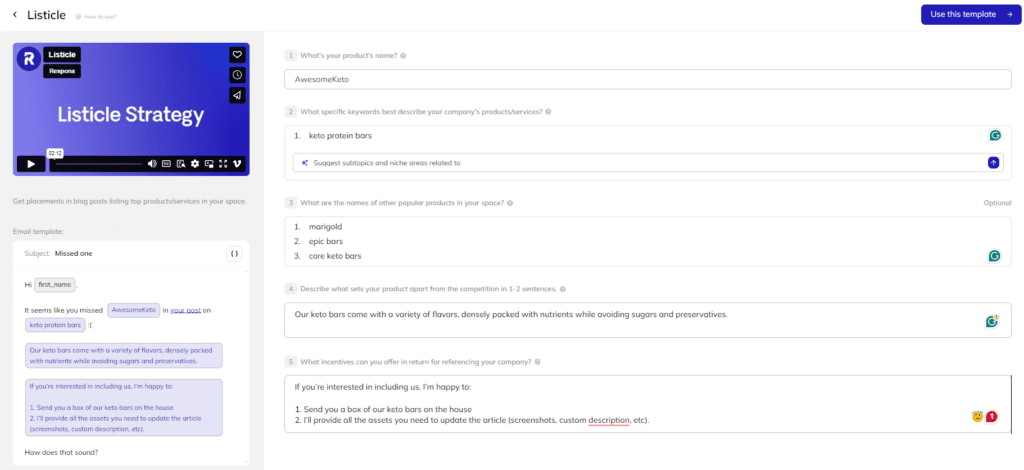
To use it, all you need to do is fill out 5 fields.
In the first one, enter the name of your product. It will be pulled into your email sequence, along with the final two fields.
In the second field, enter your target keyword (keto protein bars in our example). You can also use Respona’s AI keyword suggestions to generate up to 20 additional subtopics to help you with keyword research.
In the third field, enter some of your competitors’ names. They will be used to find listicles that feature them, but not you.
In the last two fields, enter a brief description of your product and provide an incentive for your prospect to include you in their listicle.
When all fields are filled out, click “Use this template” to get into the campaign editor.
Step #2: Prepare your outreach email
The first step of the campaign flow is all about crafting our outreach email.
Whether it’s a site owner we’re reaching out to or a blogger, we need to make sure that our email won’t go unnoticed.
Thankfully, we can create our email sequence within Respona and make sure that everything looks as it should.
At this point, we can either:
- Use a premade email template, or
- Create a new one.
In our example, we’ll go with the listicle campaign’s pre-designed template with some modifications.
Here’s how our email sequence looks before we make any edits:
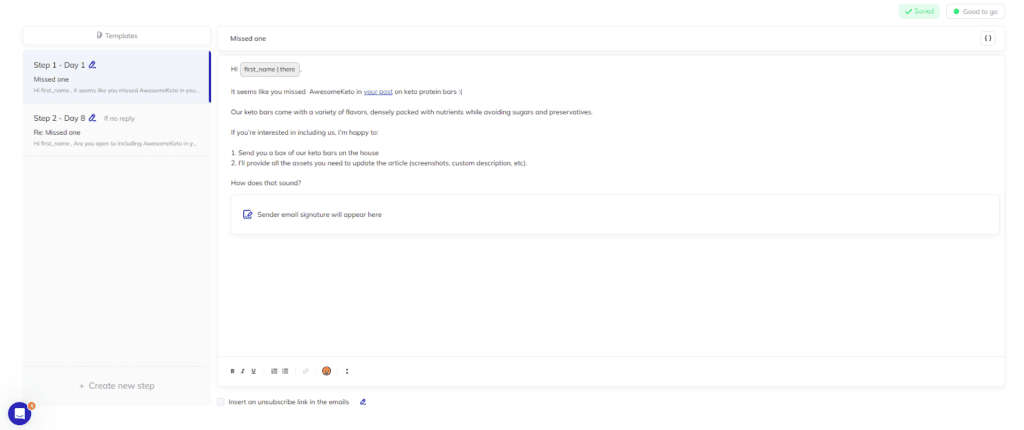
As you can see, our email is short and sweet, while also giving the email recipient a very clear idea of the purpose of our outreach.
Additionally, the email answers the “what’s in it for me” question. By providing an incentive, it encourages the recipient to not only want to reply to your message but also consider providing a backlink.
The incentive used here is a complementary protein bar because it would be an attractive offer for the author. It is important to cater your incentives to your recipients. Other types of incentives can include backlinks, social shares, guest posting, etc.
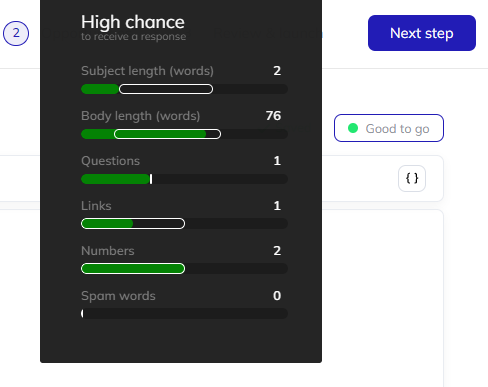
The screenshot above depicts a rather useful feature you’ll be able to use when creating your email sequence on Respona.
More specifically, the tool is autograding your email based on its subject length, word count, question count, and spam word count.
This basically helps you make sure that your email isn’t longer than it needs to be, nor is it full of words that’ll get our email straight to spam, and so on and so forth.
Let’s also spice the template up by including an AI icebreaker variable:

It will “read” your prospects’ content and come up with unique personalizations for every single opportunity in your campaign – saving you time on personalization, while boosting your reply rates.
Now, let’s also add an unsubscribe link to our sequence in case some prospects are not interested to reduce our chances of getting reported as spam and provide an easy way to opt out from any follow-ups.
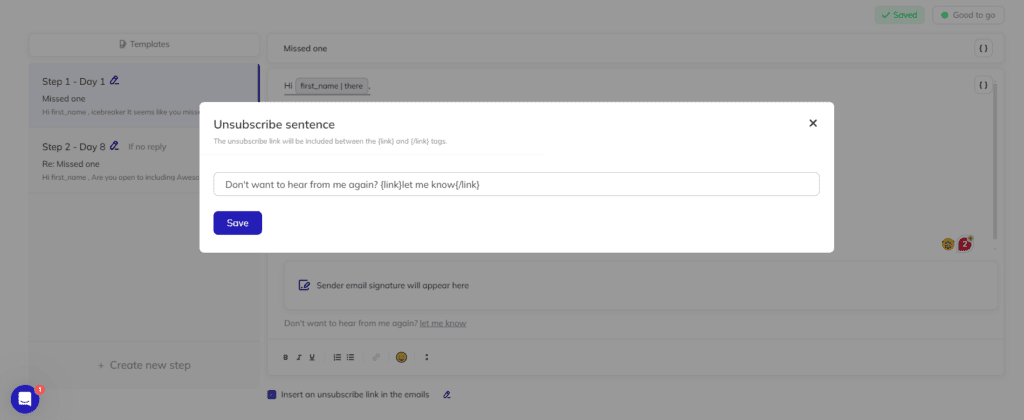
As simple as that!
Let’s get to the next exciting step.
Step #3: Find Link Building Opportunities & Their Contact Information
Here, Respona will find link prospects along with their email addresses in one go.
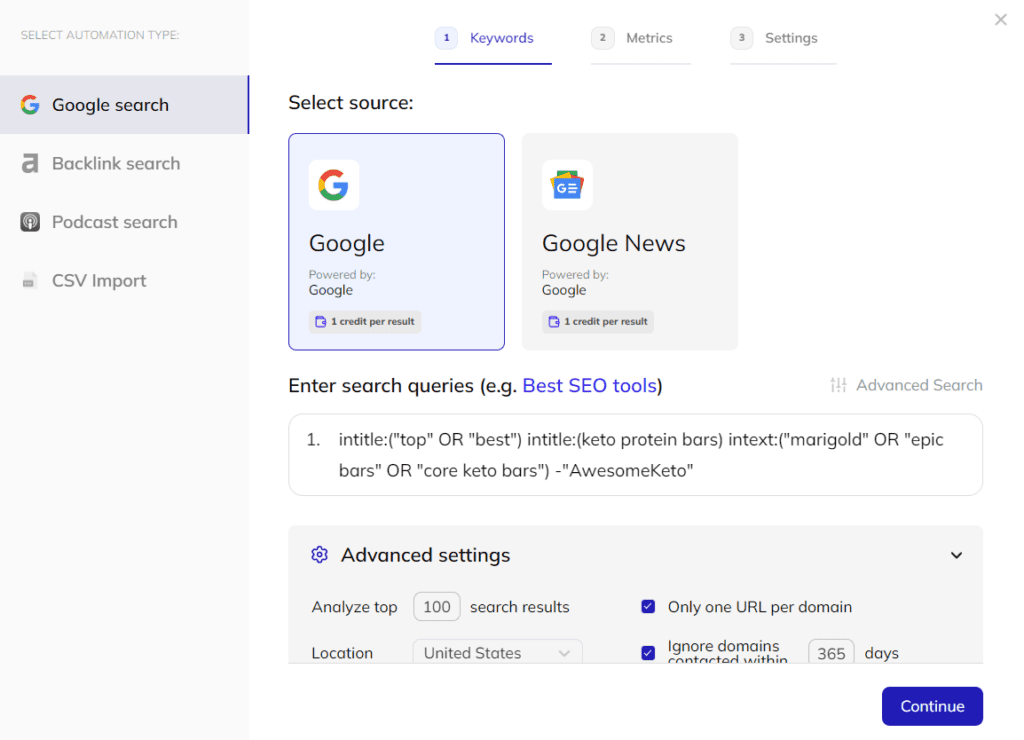
Respona’s search engine is based on Google and automatically applies advanced search operators like intitle: and intext: to find listicle posts that mention your competitors but not you.
No need to do much here besides click “Continue” and add some additional SEO filters to narrow down the results to only websites that fit your criteria.
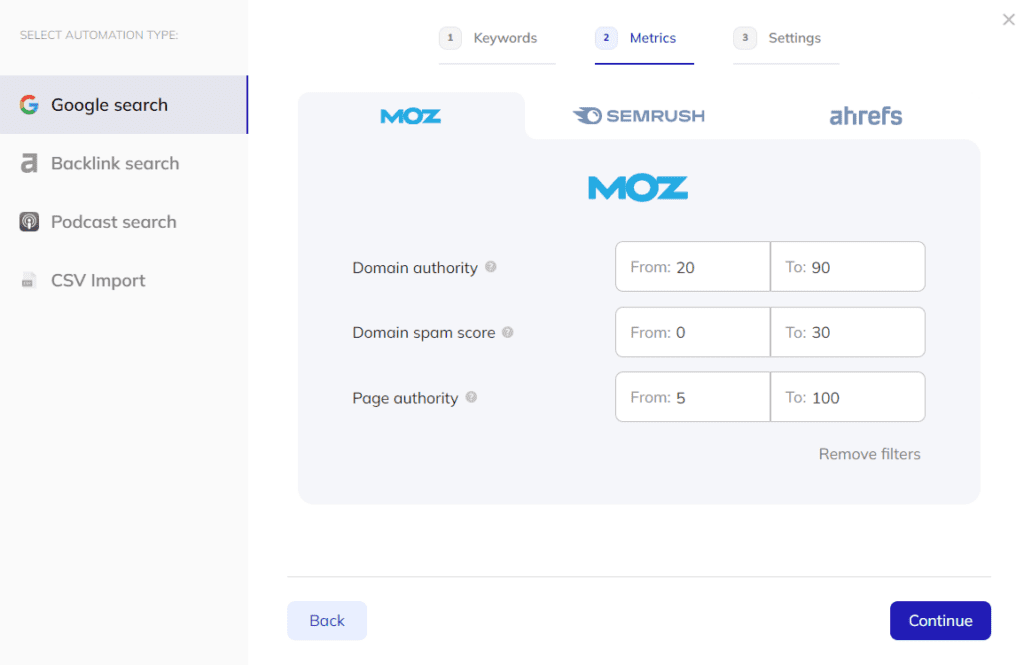
You can use Moz filters by default, or connect SEO tools like Ahrefs or Semrush to Respona to use their proprietory filters.
Click “Continue” once again to review the contact search settings.
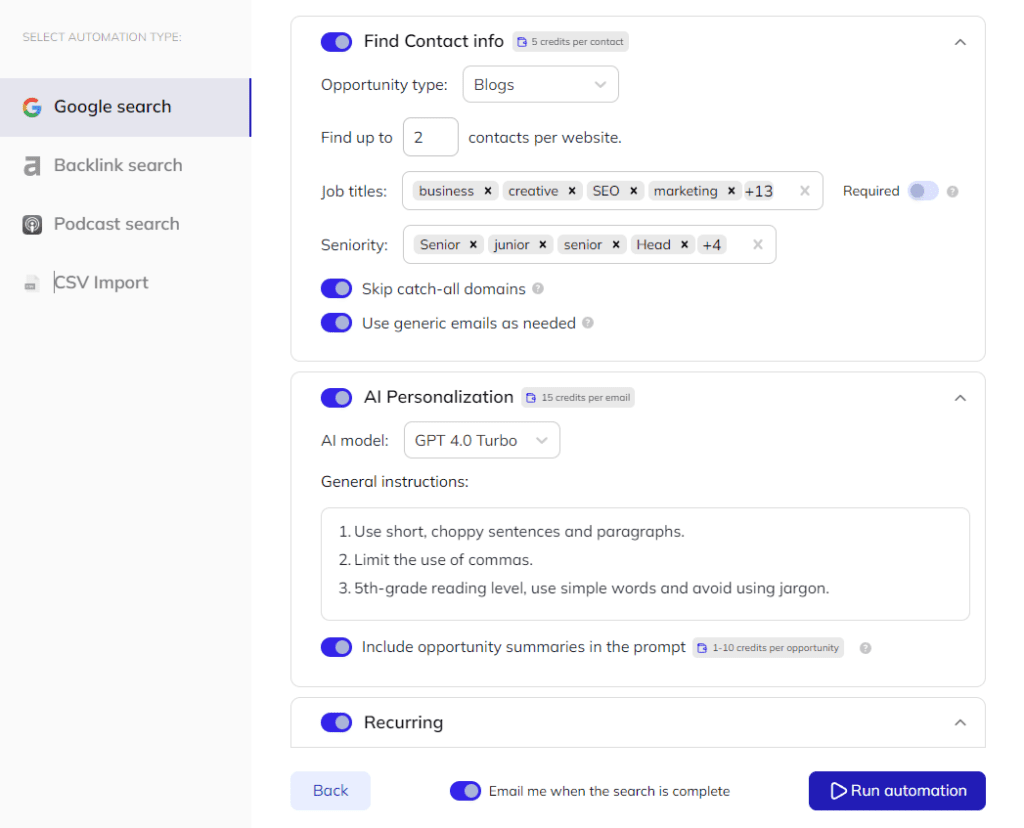
Because we used a campaign template, Respona is already set up to find relevant decision makers for listicle post inclusions – such as SEO and content managers.
In the next field, let’s also provide some additional instructions for our AI personalizations to sound more like us. These instructions can range from general tone guidelines to examples of your previous personalizations.
Let’s also enable the final option to make our search recurring. Respona will then automatically re-run the search and automatically add new opportunities to our campaign.
When everything is set up, click “Run automation” and Respona will start looking for link opportunities, their contact information, and personalize emails, all in one go.
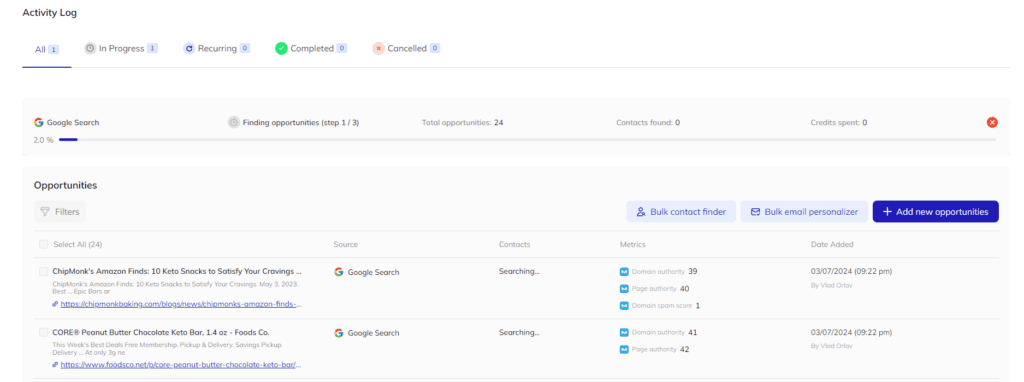
Results will start appearing on the screen as soon as they’re found.
Moving on.
Step #4: Reach out to your prospects and manage communications
Reaching out to our prospects is the final step we need to take.
To do it right, we need to make sure that we personalize our email.
A personalized email has increased chances of getting a reply, since it sounds far less spammy than a generic email that looks like it’s been addressed to a number of people at the same time.
Here, you can review your AI personalizations and make additional manual edits should you feel the need for it.
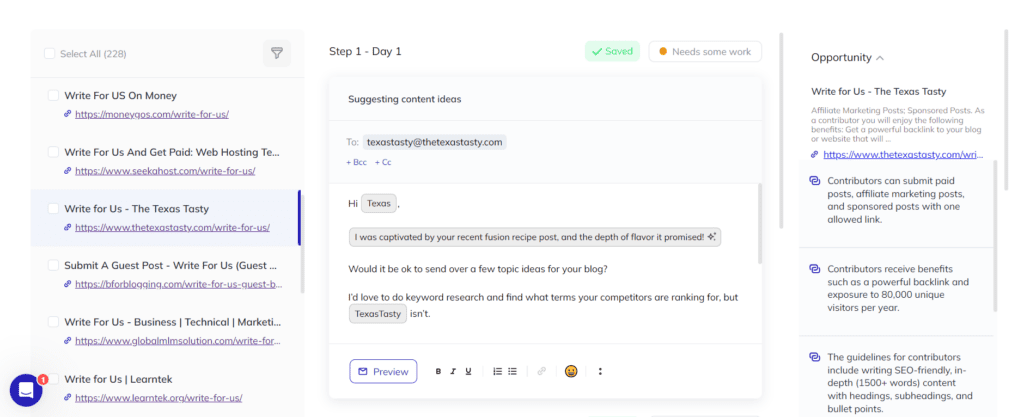
Author’s Tip: Respona also finds LinkedIn addresses of your contacts contacts, so make sure to reach out to them prior to launching your campaign, thus establishing a relationship with them and giving an extra reason to pay attention to your outreach email.
We’re now ready to actually launch our campaign.
We’ve reached and completed the final step of our four-step process.
We’ll now wrap our post up and close with some final thoughts.
Link building cheat sheet
Now Over to You
There you have it.
In this guide, we’ve talked about eCommerce link building, its importance and benefits (especially for a small business), as well as some of the most effective strategies to find links for your online store and rank higher.
We’ve also taken you through a four-step process of building your very own link building outreach campaign for your online business using Respona.
Even though link building can generally be time consuming and takes lots of hard work, having an easy-to-use tool can totally help you make the most of your link building efforts.
Consider starting your 14-day free trial with Respona and see for yourself that you can not only do link building yourself but you can also be good at it.
Good luck getting quality links for your eCommerce site!
FAQ
Is link building still relevant for SEO?
Very much so. Google’s link spam updates have only reinforced the importance of a high quality backlink profile from relevant, authoritative websites in your niche.
How is eCommerce link building different from regular link building?
The challenge eCommerce businesses face is the fact that you need a blog to build links – not just product pages, which is often a secondary priority for owners.
In general, eCommerce link building and regular link building follow the same process: creating link-worthy content and reaching out to relevant websites with your link pitch.
Are nofollow, UGC, and sponsored links obsolete for SEO?
These links do not pass “link juice”, but can still be a great way to spread awareness about your products – especially if a popular influencer reviews them or even organizes a giveaway.
Should you avoid reciprocal links altogether?
Yes – reciprocal backlinks are automatically devalued by Google, meaning that the effort you spent on building them is wasted.
What’s the best way to build valuable backlinks for eCommerce?
As we already mentioned, the best reliable way to obtain high-quality links for your eCommerce store is to invest time and resources into linkable assets, and then conduct link building outreach with the help of software like Respona.
Generally, it is advised to do link building in-house as opposed to hiring a link building service or SEO services, which you oftentimes have very little control over.



![2455 Guest Posting Sites for 2024 [Updated List]](https://respona.com/wp-content/uploads/guest-posting-sites-1024x683.jpg)



